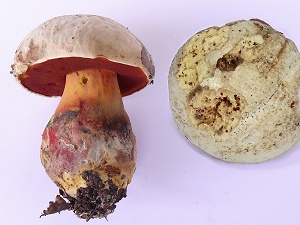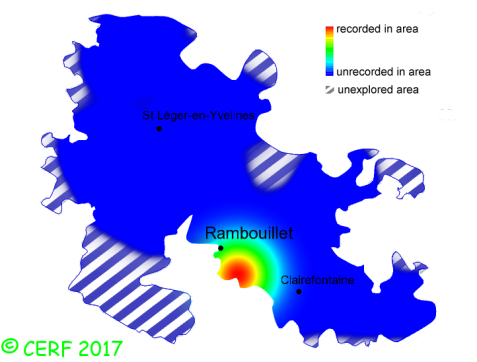| Boletus satanas Lenz |
|
|
|
|
|
|
The cap is whitish, pale grey to greenish brown (old specimens), often bounded with red at the margin, and getting dirty with age, fleshy, thick, almost spherical to hemispherical (liked a big flint stone), then convex to a bit flattened. The cap surface is slightly viscid, then downy-smooth, satin to slightly shiny and dry. The cap margin is very thick, inrolled for a long time, then often wavy. The stem is stout to bulbous, short, becoming more or less cylindrical but swollen towards its base. It is coloured with yellow at both ends (sulphur-yellow at the apex, yellow-brown at the base), and with purple-red in its middle part (pink on young specimens). It turns blue when touched or bruised. It has a network made of thin, carmin red to purple red polygonal and regular cells (whitish in young specimens) at least at its apex.. The flesh is thick, firm then soft, whitish, sometimes yellowish in some places (stem). It turns blue moderately (sometimes not at all in dry weather) but quickly when in contact with air, mostly above the tubes, before fading to whitish; its taste is mild then bitter; the odour is almost non existent in the youth, unpleasant with age (sickly, putrid or of eel); The tubes are adnate to almost free, yellow then yellow greenish, short or long (5mm close to margin or stem,20 to 30mm elsewhere), turning moderately blue when exposed to air. The pores are small, round, yellow then bright red, then eventually orange red when mature, discolouring slightly to dark blue-green when pressed. The spore print is olive brown. It grows in dry and well ventilated broad-leaved forests : woodlands, sunny clearings and wood edges, paths. It likes warm climates and is less frequent in Northern Europe. It comes on rich soils in small troops, on a rather calcareous soil, with oak, beech, chestnut, hornbeam, lime-trees. The fruiting period takes place from April to November.
Chemical tests : flesh becomes straw-yellow when in contact with ammonia. Distinctive features : whitish cap; white flesh, turning blue quickly but not strongly when exposed to air; red network present on top of stem; bright red pores, turning blue-green when pressed; stout stem, yellow surface at both ends, red in the middle; Boletus satanas is quite rare and confined in the forest of Rambouillet, and is quite rare, more generally speaking . | ||
|
page updated on 14/01/18

